Treatment
| ||||||||||||||
 Scaling removes plaque & calculus |
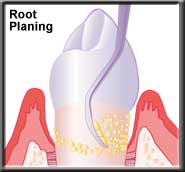 Root planing smoothes the root surface |
In a few cases, the swollen gums may not shrink back to normal after the infection is removed, and must be trimmed by the dentist with a gingivectomy. Otherwise the swollen gum makes removal of plaque by the patient very difficult, and the problem starts again.
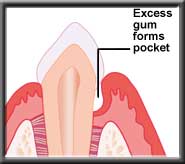 |
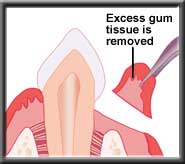 |
|
Pocket reduction with a gingivectomy |
|
In more moderate cases, there is actual bone loss, and deeper pockets. Non-surgical scaling and root planing may remove the calculus from these deeper pockets but because of limited and difficult access in reaching the bottom of the pocket some of these cases may need flap surgery.This allows us to gain access to clean the root. With this procedure, an incision is made between the gum and tooth, and the gum moved back away from the neck of the tooth and the edge of the bone. We can then easily see the deep calculus, and adequately clean the tooth.
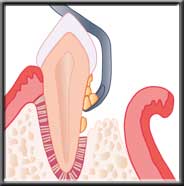 Flap reflected to access deep plaque and calculus |
After flap surgery the tissue may be returned to its former position, which minimizes cosmetic changes. However, because the gum can not connect back to the tooth, this does not eliminate the pocket. With the pocket remaining, the patient cannot remove all the bacteria, and must rely on frequent hygienist cleanings to help control reoccurrence of the infection.
 Flap returned to normal |
The ideal flap surgery, pocket elimination surgery, is achieved when we can surgically reduce the pocket by repositioning the gum down to the new bone level. Any irregularities or pitting of the bone that was caused by the infection is first corrected, and the gum is sutured tightly down to the re-contoured bone. This pocket reduction allows the patient to access and remove the bacterial plaque daily with brushing, flossing and rubber tipping. If plaque is eliminated daily, the disease can usually be arrested.
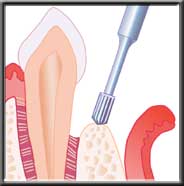
Pitted bone re-contoured during osseous surgery |
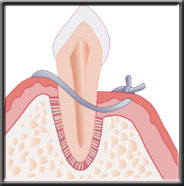
Flap sutured tightly down to recontour bone |
Pocket reduction surgery can cause cosmetic changes around the upper front teeth, and we may avoid pocket reduction surgery in this area to minimize any changes that could be seen.
In advanced cases, when there has been extensive bone loss, and pocket depth may be 8mm and more, complete removal of the pocket is often not possible. However, surgery may be necessary for the us to access and clean the deeper areas, which may not be effectively scaled without reflecting the gum. The objective is to thoroughly cleanse the roots, and to reduce the pockets as much as possible. Antibiotics may be prescribed to help eliminate very aggressive bacteria.
In the last decade there has been much research in actually re-growing the bone destroyed by periodontal disease. While not effective in all cases, today many periodontal lesions can benefit from these regeneration procedures. We will tell you if you are a good candidate for regeneration.
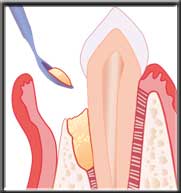 Placing bone graft |
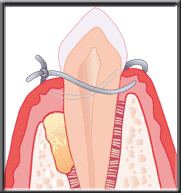 Bone placed in defect |
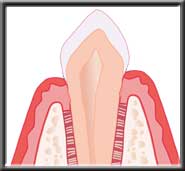 Bone stimulates patient's natural bone to regenerate |
|
In cases where surgery is not, or cannot, be performed, or in very advanced cases, there are often residual pockets after treatment. The deeper these pockets, the more guarded the long term results will be. We try to reduce pockets as much as we can. As a rule of thumb, the shallower the pocket, the better the chances of maintaining the tooth. With a shallower pocket the hygienist is able to clean more thoroughly at recall appointments, and the patient is able to remove a greater percentage of the plaque that forms.
Periodontal disease may be considered a chronic disease, and for that reason a complete "cure" is usually not possible. Patient susceptibility may continue to be high, and the cause of infection, plaque, is always present in the mouth. Daily vigilance is needed to control the disease and keep the gums in good health. Even with the best care certain areas may lose ground, although the vast percentage of patients who follow good maintenance can expect to have their teeth for their lifetime.
In summary, the treatment of periodontal disease focuses on removing bacterial plaque and calculus that forms under the gums. In more severe cases surgery is used to provide access for scaling, and to reduce pocket depth so the patient can more effectively access and remove plaque from their teeth at home. Fastidious oral hygiene along with regular periodontal maintenance appointments (recalls) will help preserve the teeth for a lifetime.





 Treating Periodontal Disease
Treating Periodontal Disease